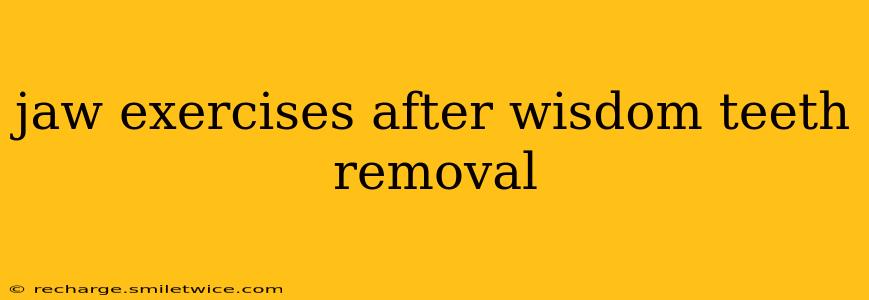Wisdom teeth removal is a common procedure, but the recovery process can be uncomfortable. Swelling, pain, and stiffness in the jaw are all typical experiences. While complete rest is crucial in the initial stages, gentle jaw exercises can aid in recovery, reducing stiffness and promoting healing. However, it's crucial to proceed cautiously and follow your oral surgeon's specific instructions. This guide will explore safe and effective jaw exercises post-wisdom teeth removal, addressing common questions and concerns.
What are the best jaw exercises after wisdom teeth removal?
The best jaw exercises after wisdom teeth removal are gentle and focus on restoring range of motion without causing pain or disrupting the healing process. Avoid any strenuous movements that could dislodge blood clots or put pressure on the extraction sites. Here are some examples:
- Gentle jaw opening and closing: Slowly open and close your mouth, only as far as comfortable. Repeat 5-10 times, several times a day.
- Side-to-side jaw movements: Gently move your lower jaw from side to side, again within your comfort range. Repeat 5-10 times, several times a day.
- Chin tucks: Gently pull your chin towards your chest, holding for a few seconds. This stretches the jaw muscles without excessive movement. Repeat 5-10 times, several times a day.
- Tongue stretches: Stick your tongue out as far as you can, then retract it. Repeat 5-10 times, several times a day. This helps maintain mobility and prevent stiffness in the surrounding muscles.
When can I start jaw exercises after wisdom teeth removal?
The timing of starting jaw exercises varies depending on individual healing and your surgeon's recommendations. Typically, you'll want to wait until the initial swelling and pain subside, usually a few days after the surgery. Always consult your dentist or oral surgeon before starting any exercises. They can assess your healing progress and provide tailored advice. Ignoring their instructions could impede healing or lead to complications.
How long should I do jaw exercises after wisdom teeth removal?
There's no one-size-fits-all answer to this question. The duration of jaw exercises depends on your individual recovery. Start with short sessions (a few minutes) and gradually increase the duration as you feel more comfortable. Listen to your body; if you experience pain or discomfort, stop immediately. Consistency is key, however. Regular, gentle exercises are more beneficial than sporadic, intense ones.
Are there any jaw exercises I should avoid after wisdom teeth removal?
Yes, avoid any exercises that could cause pain, excessive pressure on the extraction sites, or risk disrupting the blood clots. This includes:
- Wide yawning: This puts significant stress on the jaw and extraction sites.
- Forceful chewing: Stick to soft foods initially and avoid anything that requires vigorous chewing.
- Any exercise causing pain: Discomfort is a clear signal to stop the exercise and rest.
What if I experience pain while doing jaw exercises after wisdom teeth removal?
Pain is a warning sign. If you experience pain during jaw exercises, stop immediately. Pain during the healing process is normal, but pain while exercising indicates you're doing too much too soon. Reduce the intensity and duration of the exercises, and consult your oral surgeon if the pain persists.
How can I prevent jaw stiffness after wisdom teeth removal?
Prevention is crucial. Following your oral surgeon's aftercare instructions is vital. This includes:
- Regular rinsing: Gentle rinsing with saltwater helps keep the extraction sites clean.
- Ice packs: Applying ice packs to your jaw reduces swelling and pain.
- Soft food diet: Eating soft foods minimizes stress on your jaw.
- Keeping hydrated: Drinking plenty of fluids aids in healing.
Remember, everyone's recovery process is unique. Always prioritize your comfort and follow your oral surgeon's advice. These jaw exercises are meant to aid recovery, not to replace professional medical guidance. By following these guidelines and communicating with your dentist, you can facilitate a smoother and more comfortable recovery after wisdom teeth removal.
